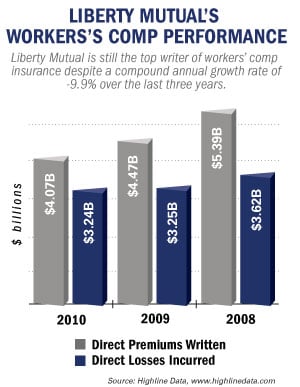NU Online News Service, Aug. 18, 10:07 p.m.EST
| Liberty Mutualsays it has evaluated hundreds of thousands of lost-time claims andmillions of medical billing transactions to enhance its predictivemodel for workers' compensation claims costs, which are growingfaster than inflation.
Liberty Mutualsays it has evaluated hundreds of thousands of lost-time claims andmillions of medical billing transactions to enhance its predictivemodel for workers' compensation claims costs, which are growingfaster than inflation.
The Boston-based insurer says it has analyzed its database tocome up with highly predictive variables to identify potentialhigh-cost workers' compensation claims—a challenge for brokers,agents, and buyers.
|The insurer says it ran more than 200,000 lost-time claimsthrough the model to prove its accuracy after assessing825,000 lost-time claims and 140 million medical billingtransactions.
|What is being billed as Liberty Mutual's “next generationpredictive model” can identify these claims as early as claimintake, says George Neale, general manager of claims for LibertyMutual's Commercial Markets segment.
|“In addition, we continuously assess the risk of escalation ofour entire inventory through several modeling stages,” he explainsin a statement. “Arming our claims handlers with this informationgives us a unique opportunity to apply strategies and expertresources at a point in time where they maximize our ability toachieve the best possible outcome for injured workers and ourpolicyholders.”
|The new model is the latest edition to VantageComp, the insurer's approach to claims management.Liberty Mutual created one of the first workers' compensationclaim-cost models in 2004.
|Beyond medical and billing data, Liberty Mutual's Center forDisability Research says it can identify psychological and socialissues, as well as co-morbid medical conditions. The model can lookat all data points together and over time to analyze the impact ona workers' compensation claim.
|According to the National Council on Compensation Insurance(NCCI), the average indemnity cost of a lost-time claim grew 47percent over the last decade. The medical portion of this type ofclaim increased 95 percent during the same time period, from$14,200 in 2000 to $27,700 in 2010.
Want to continue reading?
Become a Free PropertyCasualty360 Digital Reader
Your access to unlimited PropertyCasualty360 content isn’t changing.
Once you are an ALM digital member, you’ll receive:
- All PropertyCasualty360.com news coverage, best practices, and in-depth analysis.
- Educational webcasts, resources from industry leaders, and informative newsletters.
- Other award-winning websites including BenefitsPRO.com and ThinkAdvisor.com.
Already have an account? Sign In
© 2024 ALM Global, LLC, All Rights Reserved. Request academic re-use from www.copyright.com. All other uses, submit a request to [email protected]. For more information visit Asset & Logo Licensing.








